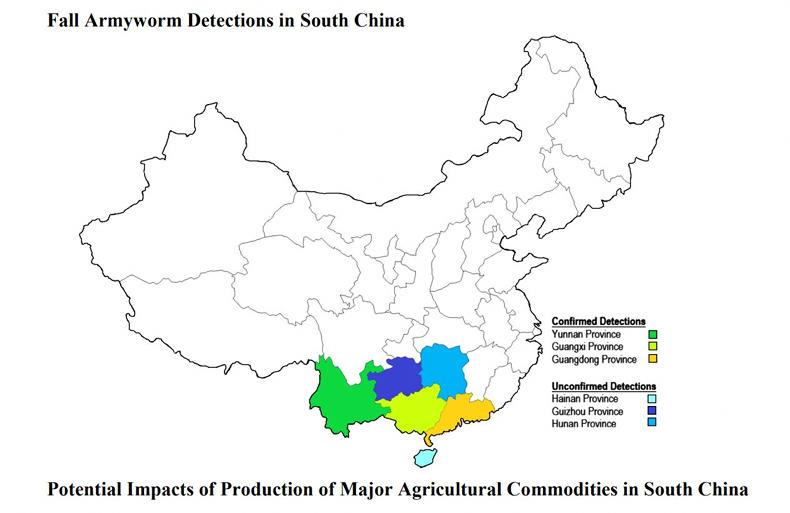The fall armyworm (Spodoptera frugiperda), a crop-eating pest, has spread across China’s southern border and has so far affected around 8,500ha of crops.
The pest is the larval form of the armyworm moth and has no natural predators in China.
As well as lowering crop quality, its presence may result in yield reductions and total crop destruction.
The pest has spread to the key grain production regions in Yunnan, Guangxi, Guangdong, Guizhou, Hunan and Hainan.
However, according to a USDA report, experts suggest that there is a high probability that the pest will spread across all of China’s grain production area within the next 12 months.
Spread
On 29 January 2019, China’s ministry of agriculture and rural affairs (MARA) reported the first detection of the fall armyworm in the Yunnan province to the International Plant Protection Convention (IPPC).
Multiple sources have suggested that the pest entered China from neighbouring Myanmar.
Private and government-affiliated crop protection experts in China report that the armyworm has spread much faster than they expected.
More recently, the pest was detected in isolated pockets of summer-season maize in the Yunnan province.
In the Guangxi province, the pest has been detected in about one-quarter of all counties.

The regions in China effcetd by the Fall Armyworm.
Damage
Fall armyworm is an invasive plant pest which is endemic to North America.
The pest consumes plant material and grain of more than 80 species of plants, including maize, rice, wheat, sorghum, sugarcane, cotton, soybean, and peanuts.
Control
To mitigate the threat, Chinese producers mainly rely on chemicals, biological controls - such as fungi or bacteria - or crop management practices - such as crop rotation.
However, there are currently no pesticides registered to control fall armyworm for any crops in China.
MARA is taking emergency measures to monitor and control the spread.
Chinese officials reportedly administered a national crop protection monitoring and surveillance programme with offices in each local agricultural bureau, implementing a trapping and scouting programme.
While it is difficult to assess the production loss associated with fall armyworm, the pest continues to spread throughout China.
Environmental conditions in south China are similar to those in parts of south and southeast Asia, where farmers have been dealing with the pest for the past two years.
In these regions, chemical pesticides and rainy weather have mitigated the spread and impact of the pest.
Read more
New voice for the tillage sector
Tillage management: crops progressing well despite cold weather
The fall armyworm (Spodoptera frugiperda), a crop-eating pest, has spread across China’s southern border and has so far affected around 8,500ha of crops.
The pest is the larval form of the armyworm moth and has no natural predators in China.
As well as lowering crop quality, its presence may result in yield reductions and total crop destruction.
The pest has spread to the key grain production regions in Yunnan, Guangxi, Guangdong, Guizhou, Hunan and Hainan.
However, according to a USDA report, experts suggest that there is a high probability that the pest will spread across all of China’s grain production area within the next 12 months.
Spread
On 29 January 2019, China’s ministry of agriculture and rural affairs (MARA) reported the first detection of the fall armyworm in the Yunnan province to the International Plant Protection Convention (IPPC).
Multiple sources have suggested that the pest entered China from neighbouring Myanmar.
Private and government-affiliated crop protection experts in China report that the armyworm has spread much faster than they expected.
More recently, the pest was detected in isolated pockets of summer-season maize in the Yunnan province.
In the Guangxi province, the pest has been detected in about one-quarter of all counties.

The regions in China effcetd by the Fall Armyworm.
Damage
Fall armyworm is an invasive plant pest which is endemic to North America.
The pest consumes plant material and grain of more than 80 species of plants, including maize, rice, wheat, sorghum, sugarcane, cotton, soybean, and peanuts.
Control
To mitigate the threat, Chinese producers mainly rely on chemicals, biological controls - such as fungi or bacteria - or crop management practices - such as crop rotation.
However, there are currently no pesticides registered to control fall armyworm for any crops in China.
MARA is taking emergency measures to monitor and control the spread.
Chinese officials reportedly administered a national crop protection monitoring and surveillance programme with offices in each local agricultural bureau, implementing a trapping and scouting programme.
While it is difficult to assess the production loss associated with fall armyworm, the pest continues to spread throughout China.
Environmental conditions in south China are similar to those in parts of south and southeast Asia, where farmers have been dealing with the pest for the past two years.
In these regions, chemical pesticides and rainy weather have mitigated the spread and impact of the pest.
Read more
New voice for the tillage sector
Tillage management: crops progressing well despite cold weather







 This is a subscriber-only article
This is a subscriber-only article











SHARING OPTIONS: